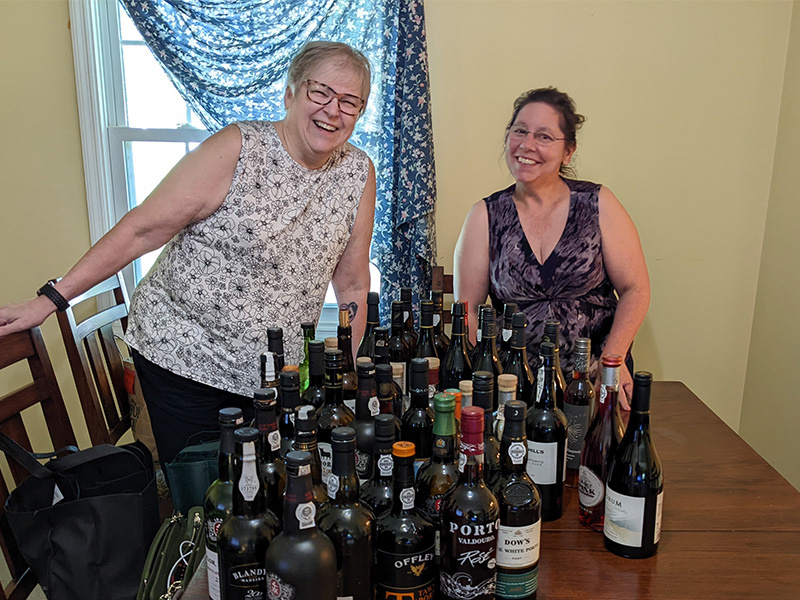Fortified Out
- Posted on
- 0

At the time that this blog will be emailed out and posted to the City Vino website, store owner Rita Allan and myself, blog writer Kathy Wiedemann, will be in the frantics studying. Both of us are currently enrolled for the Wine and Spirit Education Trust (WSET) Diploma Unit D5 Fortified Wine examination. The exam is being held on Tuesday, June 7, 2022, between 3:30 and 5:30 pm, at Capital Wine School in D.C., close to Chevy Chase, Maryland.
The WSET Diploma is the highest certificate that the organization presents, and is often a steppingstone for those who seek further mastery of wine, through the Institute of the Master of Wine, yielding the post-nominal MW. There are currently 419 Masters of Wine in the world. Jay Youmans, who owns Capital Wine School, is a Master of Wine as is school-instructor Caroline Hermann.
There are six units to the WSET Diploma certification. They are Wine Production, Wine Business, Research Paper, Fortified Wines, Sparkling Wines, and “Light” Wines of the World. I put quotes around the word light because “light” doesn’t mean light-bodied wines. In this context, light means any wine that is non-fortified and non-sparkling. This is indeed a vast category of wines and the most demanding and grueling of the units.
As of this writing, Monday, May 30, I will be headed shortly to Rita’s home, to practice our fortified wine tasting abilities. I have about 19 bottles of fortified goodness packed in wine carrying bags ready to take along. Rita also has some wines ready to share and taste through. We will be tasting and SPITTING Sherry, Port, Madeira, Vin Doux Naturels (VDN) and an almost Rutherglen.
The format of our WSET Diploma Unit D5 Fortified Wine exam will include a tasting of three wines and two to four theory questions, all to be completed in 90 minutes. Each part of the examination has certain weighting to it. One theory question may be weighted heavy at 45 percent of the all the theory questions, and another question may be 15 percent, if it requires a simpler, less-detailed, less complex answer.
For the wine-tasting component of the exam, we have to describe the wine’s clarity, color, aromatic intensity, aromas, acidity, tannins (if applicable), body, flavors, length, and more. We also have to state whether the wine should be drunk now or will improve with ageing and judge the quality of the wine.
For the quality of the wine, we need to back up our judgement with commentary—perhaps about what grapes were used to make the wine, and what techniques were used.
For the quality of a Madeira wine, one that is made via estufagem, which is heated in a tank for a minimum of three months, is going to be less complex than a wine made via canteiro, where barrels of wine are placed in different places within a warehouse that have varied temperatures for various lengths of time.
Theory questions may include direct questions to describe certain styles of wine indicated. For VDNs, we could be asked about three styles: Grenat, Tuile, Ambre. Grenat is an unoaked red wine, Grenat Blanc is an unoaked white wine, Tuile is an oaked red wine, and Ambre is an oaked white wine. We would probably include the grapes and regions for each of these styles.
Other more intensive theory questions may involve comparing two specific types of fortified wines that are in different categories. Perhaps we would be asked to compare the base wines, maturation process, and final wines for a 20-year-old Tawny Port and VOS Oloroso Sherry. The key to these types of exams is to read the question and answer what is asked, and not do a complete mind-dump of everything you know about Tawny Port and Oloroso Sherry.
For the next week up until 3:30 pm, June 7, Rita and I will be reading up on fortifying spirits strength and point of fortification in the winemaking process, biological versus oxidatively ageing in Sherry, the allowed grapes in Madeira, ageing requirements in the various styles of Port, governing bodies, and legal regulations, and so much more. Our co-workers will be observing us being “fortified out” zipping around on high sugar and high alcohol, waiting of for the day to drink something that isn’t fortified.
Cheers!

Good Luck Ladies - Study Hard :)